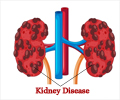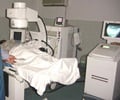A recent study of living kidney transplant donor chains showed that 46 percent of recipients are minorities.

"We were incredibly happy with the results," said study first author Dr. Marc Melcher, a transplant surgeon at Stanford Hospital & Clinics and assistant professor of multi-organ transplantation surgery at Stanford University. "It demonstrates that through the cooperation of altruistic strangers we can generate multiple transplants and reduce the competition for deceased organs."
The study, which appears in the September issue of the peer-reviewed American Journal of Transplantation, notes that the larger percentage of minority recipients may be a result of large urban centers with more ethnic diversity actively participating in chains.
"About 30 percent of patients needing a kidney transplant discover that their friends and relatives are incompatible as donors. Donor chains create opportunities for potentially endless donor-recipient pairings," Melcher said.
A chain can start when an altruistic donor generously donates a kidney to a stranger on dialysis. This recipient's original incompatible willing donor then passes on the generosity to another patient on dialysis to keep the chain going, essentially "paying it forward," and the process can be repeated to extend the chain further.
This collaborative effort is made possible thanks to kidney registries like the National Kidney Registry, a nonprofit organization that uses a specialized computer program to match donors and recipients across the country. The registry has helped hundreds of patients who have antibodies to their loved ones receive a kidney from a stranger as part of a chain of transplants. The world's longest kidney transplant chain, facilitated by the registry, involved 60 patients.
Advertisement
About 92,000 people currently are on the kidney transplant waiting list in the United States, according to the United Network for Organ Sharing. California alone has more than 16,000 people on the list. Patients often can wait more than a decade for a suitable organ, and about 19 percent of those on the waiting list are seeking their second, third or fourth kidneys.
Advertisement
"Dialysis is typically three times a week, four hours a day. The procedure is extremely draining, which is why patients often lose their jobs and cannot lead normal lives," Melcher said. "The worst part is that over 4,000 patients a year die while on the waiting list for kidney transplants. So many lives could be saved if we can expand the living kidney transplantation donor chain program."
Increasing the number of kidney transplants per year also reduces health care expenditures, Veale said. It costs about $70,000 a year to maintain a patient on dialysis, while it costs only about $20,000 to care for a patient who has undergone transplantation, most of that expense is for medications and follow-up visits. Additionally, living donor kidneys last about twice as long as organs removed from deceased donors. Therefore, the health system saves approximately $500,000 each time a patient receives a transplant, Veale said. It is one of the few examples in medicine where the standard of care is much less expensive than the next option — dialysis, in this case.
The next step, which Veale reported recently in the New England Journal of Medicine, is to expand the donor pool internationally, possibly into Canada or Europe, similar to what happened with the bone marrow registry.
"A kidney that could free a patient in California from the constraints of dialysis may be found in a donor who lives in London, Barcelona or Vancouver," said Veale, who also is director of the UCLA Kidney Exchange Program.
One recipient's story:
For La Canada resident Keenan Cheung, a 47-year-old housing director at the University of Southern California, a kidney transplant chain was life changing. Cheung was born with polycystic kidney, an inherited disease in which many cysts form in the kidneys. He was fine until his 40th birthday, when his kidneys started to fail. He put his name on a waiting list for a donor kidney and began continuous ambulatory peritoneal dialysis, a four-times-a-day process that required a tube in his peritoneum by which waste products were removed from the blood and excess fluid drained from his body.
After several years on dialysis, he suffered a grand mal seizure in January of 2009. His health quickly deteriorated. He already knew that his wife, Jeanne, and his brother and mother were not compatible donors. Joining a kidney chain became the ideal solution for him. Cheung received a kidney from an African American man in Long Beach who couldn't donate his kidney to his mother because they were incompatible. Cheung's wife, Jeanne, then donated her kidney to a Hispanic girl from Commerce who needed an organ but didn't have a match.
Cheung got his transplant in June of 2009 and is doing wonderfully, living a full and happy life and coaching all three of his sons' sporting teams.
"I was on death's doorstep. I was miserable," Cheung said of his life prior to the transplant. "Today I could not be better. I'm healthy, I exercise, I coach my sons' teams. I can golf, swim, hike — all of the things I couldn't do on dialysis. Getting this kidney was life changing."
Source-Eurekalert















